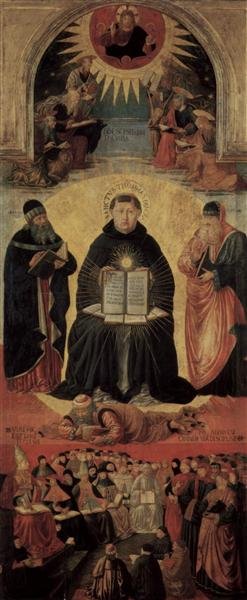Saint Thomas and the Common Good

The Triumph of Saint Thomas Aquinas by Benozzo Gozzoli, public doman
In Catholic Social Teaching and Catholic political philosophy, the common good is a key concept. But, it often seems to us moderns like an impossibly gassy abstraction.
Yesterday, I came across a nice summary of St. Thomas Aquinas’ teachings on the common good, which I think can help. See’s see what Fr. Bonaventure Chapman has to say.
…you may muse: “What is the common good?” Bonum commune, the common good, is one of those weird concepts that seems self-evident but upon further reflection is a bit mysterious in meaning. Perhaps a good way to start defining it, in the venerable tradition of negative theology, is by saying what the common good is not. This, at least, is the route the Compendium of the Social Doctrine of the Church takes:
The common good does not consist in the simple sum of the particular goods of each subject of a social entity. (164)
But things get a little fuzzier when some kind of positive definition is offered, a definition stemming from a whole host of magisterial texts (see footnote 346 of the Compendium for these references):
According to its primary and broadly accepted sense, the common good indicates ‘the sum total of social conditions which allow people, either as groups or as individuals, to reach their fulfilment more fully and more easily.’ (164)
So the common good is the “sum total” of “social conditions” which allow people to “reach their fulfillment.” Is there a doctor in the house who can help unpack this? Perhaps a doctor communis to explain the bonum commune?
As Fr. Chapman says, the common good is about people reaching their fulfillment. But, it is not simply a summation of personal, private, or individual goods. Catholic thought deviates sharply from all kinds of utilitarianism here. Fr. Chapman continues on this theme:
As the magisterial documents make clear, “sum total” cannot mean a mere aggregate of things, nor some utilitarian calculus of the greatest possible conditions for the greatest number of social beings. Well then, what kind of “total” is it? For St. Thomas, it is an ordered totality, a totality of parts working together in one uniform way for a common goal. The common aspect in common good is not a catalogue or IHOP restaurant menu with a million individual options all present for the choosing; it is the organic unity of varied and sundry parts working together for one end.
St. Thomas liked to make analogies to how the bodies of living things worked. We would likely make analogies to machines instead of bodies, but in English at least being “a cog in the machine” has something of a negative connotation of being uniform and interchangeable, whereas St. Thomas intends for each part of the organic whole to be unique, different, and valuable.
Another big difference for us, and likely the hardest to wrap our minds around, is that St. Thomas, following Aristotle and Plato, held that there was one, unique, highest good that all people were oriented toward. St. Thomas of course identifies this highest good as God. The common good is then our progress toward God.
That identification is hard for moderns to accept. I’m sure most people in America would immediately have visions of theocratic despotism. However, even if you abstract that away, I don’t think most of us would even really accept that there is a unique, highest good. Different people are different, pursuing diverse goals and ways of life.
I think this is why the common good makes very little sense to so many people. Whether this is actually true is an entirely different matter, but I think it is the primary stumbling block most people have.



Comments ()